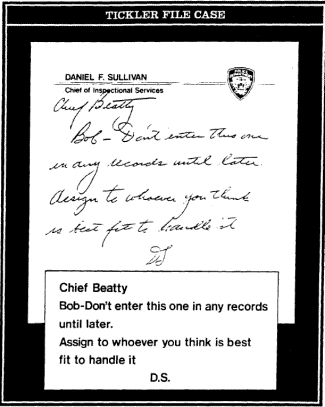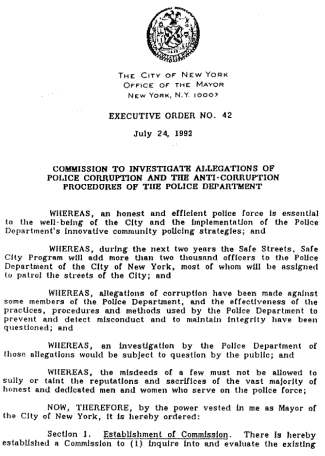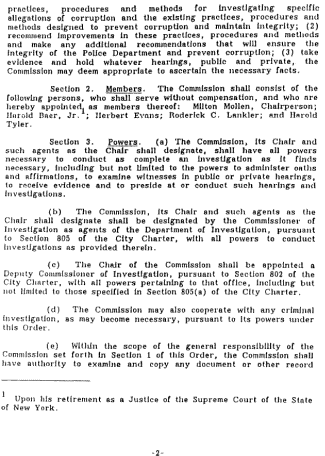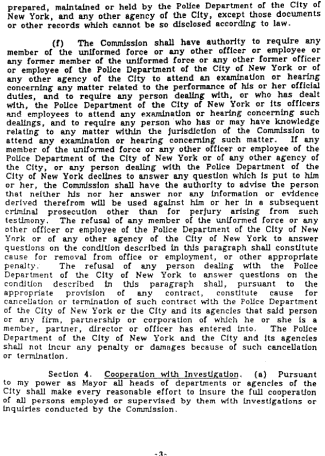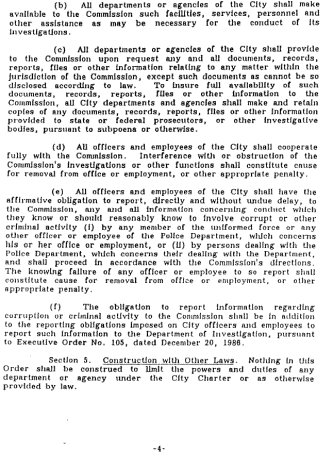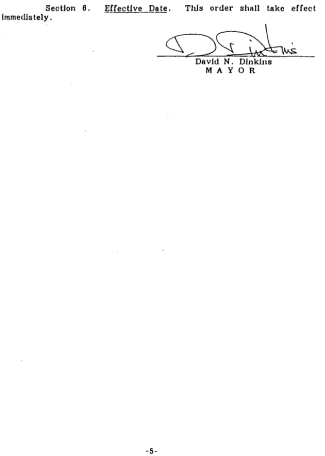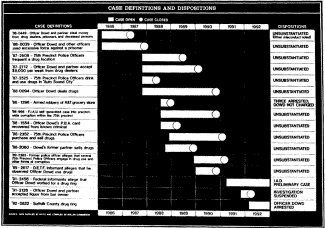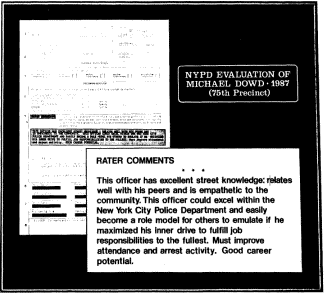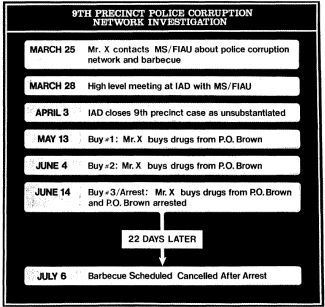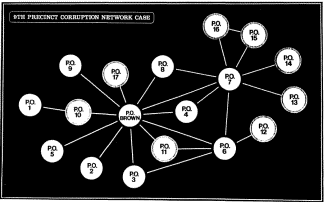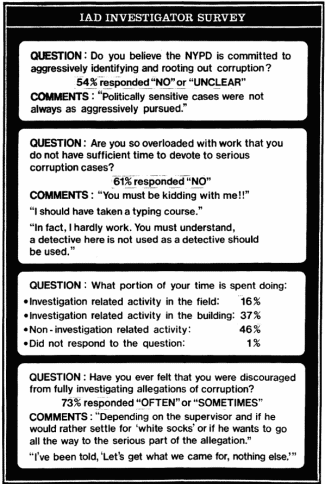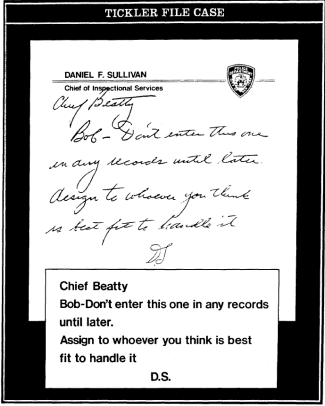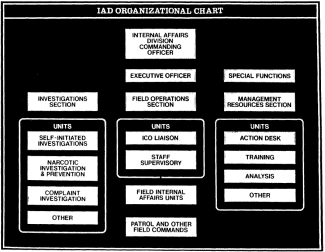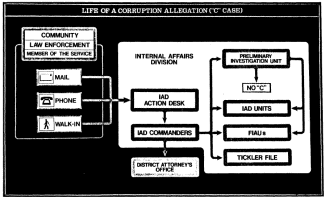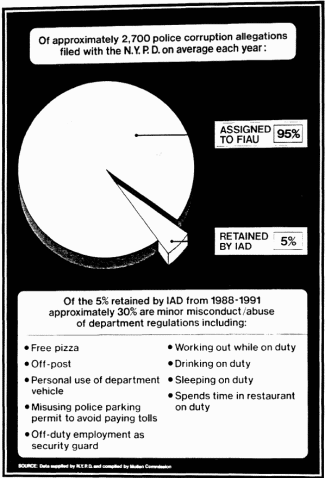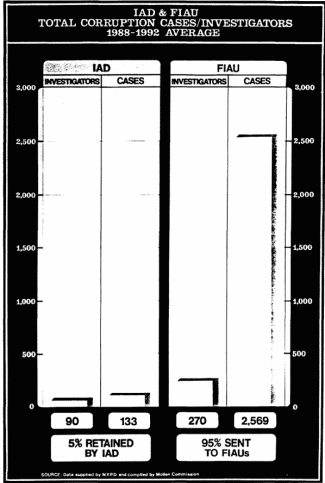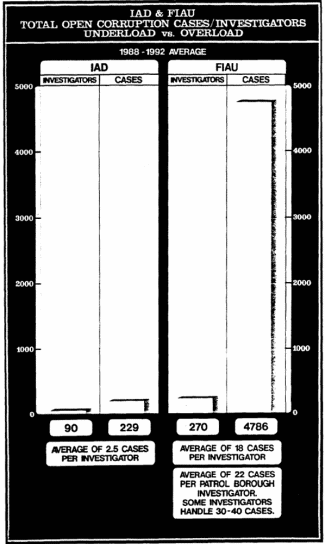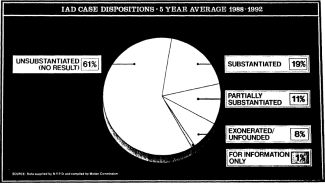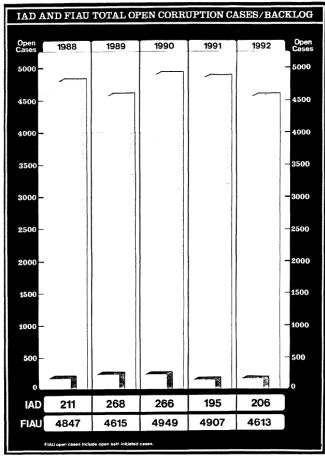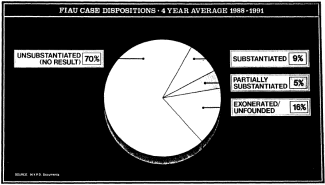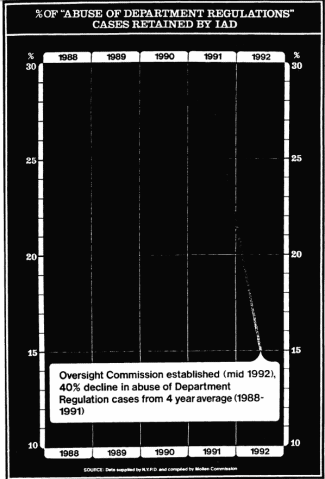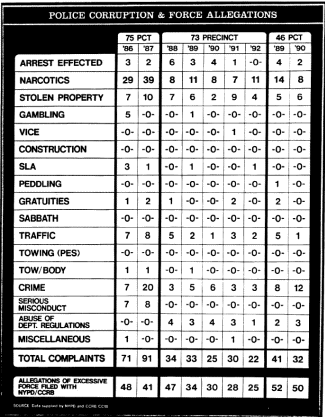CHAPTER FOUR: THE COLLAPSE OF THE DEPARTMENT'S CORRUPTION CONTROLS
"All parts of the Department's corruption systems had been functioning terribly for years ... top commanders in and outside of Internal Affairs didn't seem too concerned about that however because it guaranteed no bad headlines ... but when they heard an independent monitoring Commission was being set up to see how they were doing in the corruption area, things started quickly changing...."
-- IAD Supervisor, Private Interview with Commission Staff, September 23, 1993
To fulfill our mandate to investigate the quality of the Department's corruption controls, the Commission made numerous requests for documents and information that set forth the Department's anti-corruption practices and performance over the past decade. We were astounded to learn that -- unlike other commands in the Department -- virtually no information on the overall performance of the anti-corruption systems existed, and the little that did was largely inaccurate. We then subpoenaed officers of all ranks who were assigned to and supervised portions of the Department's anti-corruption apparatus. We were again astounded to learn that many did not know how certain anti-corruption systems were supposed to work or how certain programs and units, many established during the Knapp Commission era, were functioning today.
The Commission therefore started from scratch in investigating and auditing what should have been the principal components of the Department's anti-corruption systems. These include: (i) command accountability and supervision; (ii) internal investigations and intelligence gathering; (iii) recruitment and screening; (iv) training; and (v) the police attitudes and culture that nurture and protect corruption. This had never been done before because -- unlike other City agencies -- the Department had been allowed to police itself alone, with no independent oversight to insure it was doing its job well.
Our investigation found a system that had virtually collapsed years ago -- and that was more likely to minimize or conceal corruption than uncover and uproot it. We found that the New York City Police Department had largely abandoned its responsibility to police itself and had failed to create a culture dedicated to rooting out corruption.
The reason for this collapse can be summarized in a few words: a deep-seated institutional reluctance to uncover serious corruption with no independent external pressure to counter it. From the top brass down, there was an often debilitating fear about police corruption disclosures because it was perceived as an embarrassment to the Department, and likely to engender a loss of public confidence. From the top brass down, there was a widespread belief that uncovering serious corruption would harm careers and the Department's reputation. As a result, avoiding bad headlines, and tolerating corruption, became more important than eradicating it.
This attitude infected the entire Department, manifesting itself in different ways throughout the ranks. It encouraged the Department's top managers to allow corruption controls to wither through neglect and denial of resources, and to allow the principle of command accountability to collapse through lack of enforcement. That encouraged local field commanders -- who can best prevent and uproot corruption because of their daily interaction with and authority over the vast majority of officers on the streets -- to ignore evidence of corruption on their watch or to transfer problem officers out of their commands. When this happens, the Department loses a powerful tool for changing the culture of the Department. It also sends a powerful message to patrol officers who are most susceptible to corruption's allure: that despite obligatory rhetoric to the contrary, corruption is tolerated in the stationhouses of this City.
This fear of corruption disclosures infected the Department's internal investigative apparatus as well. Officers of all ranks in the Internal Affairs Division ("IAD") and the Field Internal Affairs Units ("FIAUs") testified in the course of our investigation that the commanding officers of IAD -- and the top managers of the Department -- wanted to minimize the likelihood of uncovering serious corruption. One IAD detective, to whom we promised confidentiality, said he was expected to have a "see no evil, hear no evil" approach to corruption investigations. A former IAD supervisor told the Commission that IAD investigators and supervisors understood that their mission was "damage control", not uncovering serious corruption. The six-year chief of the Department's Inspectional Services Bureau, Daniel Sullivan, confirmed that the highest levels within the Department wanted Internal Affairs and local field commanders to be toothless in fighting corruption. He testified at the Commission's public hearings that:
There was a message that went out to the field that maybe we shouldn't be so aggressive in fighting corruption because the Department just does not want bad press. (Tr. 25)
Numerous officers told us that the Department's desire to minimize corruption disclosures became particularly intense after the 77th Precinct scandal of 1986, when thirteen officers were indicted on charges ranging from larceny to sale of narcotics. Although the Department's Internal Affairs Division and the Office of the Special State Prosecutor [10] investigated that case aggressively, there was a pervasive perception throughout the Department that the negative publicity it generated harmed the Department and undermined public confidence in it. The former Commanding Officer of the Manhattan South FIAU, Captain Charles Luckner, for example, told us in a private interview:
Q: What would the reaction be when there was a precinct-wide scandal? Was there some embarrassment about that?
A:. Oh sure. They didn't want it.
Q: Who didn't want it?
A:. Nobody. The Department didn't want it. [Laugh] I would say the Department didn't want it from the Police Commissioner down ... I think one of the big things, if I remember correctly, was when they had the one in Brooklyn's 77th [Precinct]. And Ward was the Commissioner. He took that as a personal affront and he wanted to know how come this thing came about. Why did this blow up into a big thing like this? Why didn't they chip off one, two, three, or four or five [police officers] . . . and it wouldn't have been a big thing. You understand. Instead of making a wholesale arrest of four or five or six officers, you know, you take one here, one there, one there, one there .... It don't make headlines [Laugh] ... That seemed to be the underlying, you know, message that sort of came down.
Chief Sullivan confirmed Luckner's conclusion. He similarly testified that "the 77th Precinct case was a black eye for the Department, and they certainly didn't want to have another one of those." (Tr. 26)
There is no mystery to the Department's reluctance to uncover corruption. No institution wants its reputation tainted by corruption and scandal. This is particularly true of police departments where top commanders typically believe that careers and morale will suffer as a result of corruption revelations.
There is another reason for the Department's reluctance to uncover corruption: its success in uprooting corruption is often viewed as failure. When it comes to uncovering corruption, the Department sees itself in a no-win situation. If it succeeds in uncovering corruption, the public and the press often take these revelations as evidence of widespread management and integrity problems. On the other hand, if it fails to uncover corruption, the Department's integrity problems fester and scandal is the inevitable result. This creates little incentive to have zealous anti-corruption efforts.
An ineffective anti-corruption system, unfortunately, gives top commanders a way out of this dilemma. As long as the Department believes that success in uncovering corruption will be viewed as a graver failure than allowing it to exist, the institutional incentive to ignore evidence of corruption will only grow. A truly independent oversight monitor offers a solution. While pressing the Department to aggressively police itself, such a monitor can also assure the Mayor and the public that corruption disclosures are evidence of the Department's success in maintaining integrity.
During the hearing, Kerik stood to answer the judge's questions about his competency to enter the plea, admitting that he'd recently been under the care of a doctor.
Then, facing the prospect of admitting to eight separate crimes, he sat down, placed his hands on the table and read from a prepared statement in a firm but quiet voice.
Although he did not admit to the first count of the indictment -- conspiring to sell his office -- he acknowledged:
* Hiding a $255,000 secret payment on his apartment renovation from a mob-linked contractor.
* Speaking with city investigators looking at the contractor's ties to the Gambino crime family.
* Lying to the White House about his involvement with the contractor when President Bush nominated him to run Homeland Security.
After his plea, Kerik was returned to the Westchester County Jail. His lawyers said they will ask that he be released in the coming days.
Kerik's plea leaves a permanent stain on the reputation of his mentor, ex-Mayor Rudy Giuliani, a potential Republican candidate for governor.
Giuliani appointed Kerik to run city jails in 1998, then to head the NYPD in 2000. Both were hailed as heroes after the Sept. 11, 2001 terrorist attacks and, for a time, Kerik was President Bush's nominee to run Homeland Security.
-- Bernard Kerik Pleads Guilty to Lying About Payoff: He's First NYPD Commish to Admit to Crime, by Robert Gearty
The Department's corruption controls are no longer in a state of neglect. As has been the case historically, the Department swiftly strengthened its ability and will to police itself after the creation of an independent Commission. An anti-corruption apparatus that had been neglected for a decade became the focus of resources and reforms under the glare of outside scrutiny. We applaud this commitment and have recommended measures to insure that the pressure created by independent oversight and public attention does not abate over time.
But much can be learned by examining how badly the Department allowed its anticorruption systems to unravel. It shows the inevitable consequence of leaving anticorruption efforts solely within the control of a Department that has a natural incentive to believe it will be embarrassed and harmed by the very success of those efforts.
I. THE CREATION AND CORRUPTION OF THE DEPARTMENT'S INTEGRITY SYSTEM
To understand how the Department's anti-corruption apparatus failed to work, one must first understand how it was originally supposed to work, and compare that to its actual function.
Spreading Accountability
In response to the Knapp Commission investigation of the early 1970s, Commissioner Patrick V. Murphy reorganized the Department's anti-corruption system by distributing responsibility for fighting corruption among local commanders and in a centralized Internal Affairs Division. This was the system the Department had in place until the creation of this Commission.
Both the Knapp Commission and Commissioner Murphy understood that to successfully root out corruption in the New York City Police Department, something more than just a strong central investigative capacity would be required. Strong central investigations by skilled and determined corruption fighters was important. It was a powerful way to show the Department's commitment to dealing with corruption, and to make determinedly corrupt cops think twice before engaging in corrupt acts.
But they also believed that central investigations by themselves would not be enough to deal with the problem. In their view, corruption could be successfully prevented and detected only if field commanders played an integral part in fighting corruption and were held accountable for corruption on their watch. A completely centralized anti-corruption system could not work because it concentrated accountability for corruption control too narrowly: in a centralized Internal Affairs Division, rather than in the field. Simply put, in Murphy's view, centralizing total responsibility for anti-corruption in IAD let local commanders off the hook and eliminated the best opportunity for effectively fighting corruption.
To produce a greater impact on corruption in the police department -- to find a way to penetrate and ultimately crumble the blue wall of silence -- the Knapp Commission and Murphy believed that they had to find a way to mobilize the Department's managers, supervisors, and officers into corruption fighters rather than corruption tolerators. The cornerstone of this idea became the principle of command accountability: that all commanders are responsible for pursuing corruption in their commands and will be evaluated firmly but fairly on their performance.
The difficulty was finding some way to make this abstract principle a reality in the daily lives of the managers, supervisors and officers of the Department. The principle had to become real rather than rhetorical. To achieve this, Commissioner Murphy made some important organizational changes in corruption control within the Department.
To hold commanders responsible for corruption in their commands, they had to have the tools and resources to effectively uproot it. Murphy believed this could best be accomplished by giving them an investigative capacity. He created the FIAUs -- local, field internal affairs units -- that investigated corruption in the patrol boroughs and special commands. They reported directly to both the local borough or field commander and to IAD. In principle, the FIAUs therefore were a crucial component of the anti-corruption apparatus, that existed until the time this Commission was created.
Murphy also recognized the need for some centralized entity to conduct important or sensitive investigations and to assist the FIAUs. He therefore established a centralized IAD with three primary functions: to oversee and assist the FIAUs; to investigate serious, complex and highly-sensitive allegations of corruption; and to conduct intelligence-gathering and trend analysis for the FIAUs and IAD. This system was touted as the premier anticorruption structure in the nation -- and was emulated by law enforcement agencies both nationally and internationally. This system existed unchanged until it was restructured during the Commission's tenure in January 1993.
Despite the virtues of this system, there were two fundamental flaws that contributed to its downfall. First, although command accountability was the linchpin of the anticorruption apparatus, no institutional mechanism was ever put into place to enforce it. Its enforcement depended solely on the Police Commissioner's dedication and adherence to that principle. If the Police Commissioner did not enforce a policy of holding commanders accountable when corruption was detected, no other person or unit within the Department accepted responsibility for carrying out that important function. Over time, enforcement of command accountability completely broke down.
Second, although IAD was responsible for overseeing the entire FIAU structure and insuring its effectiveness, no institutional mechanism was ever put into place to oversee IAD and insure its successful performance. [11] The assumption was simply that the top brass would be responsible for overseeing IAD and the Department's entire anti-corruption apparatus. That worked fine for a time. But the system relied exclusively on police managers' commitment to integrity, rather than on institutionalized oversight. Once public attention and Departmental priorities shifted elsewhere, the Department's interest in corruption control began to wane. So too did any oversight of and commitment to IAD -- or to any component of the anti-corruption apparatus. Over time, the system began to decay. Officers in and out of Internal Affairs adopted the attitude that its work was not only unimportant, but that its success was perceived as a thorn in the Department's side.
When IAD's performance began to wither, so too did the entire FIAU structure. Vital resources were denied to IAD and the FIAUs; quality officers, for the most part, avoided assignment to these units; and the performance of these operations was well below what would have been tolerated in any other command. Given the Department's natural reluctance to uncover corruption, no top commander within the Department attempted to reverse the system's decline -- or, of course, alert the public as to the state of its corruption controls.
The specific time when the Department's corruption control system collapsed is difficult to answer. The erosion was gradual. Interest in integrity issues was naturally at its height during the Knapp Commission era and slowly diminished over time. Our inquiries focused primarily on the past decade, largely because of the availability of documents, files and witness recollections.
By the time this Commission commenced its inquiries in September 1992, only the skeleton of Murphy's system remained. Units and systems existed only on paper and had no direction or responsibilities in practice. This state of affairs was allowed to continue because it appeared to protect the Department and satisfied its top commanders. No one in the Department had any incentive to fix what had broken, until their feet were held to the fire of public scrutiny.
The New Anti-Corruption Apparatus
Early in the Commission's life, after the revelation of officer Michael Dowd's corrupt activities as uncovered by the Suffolk County District Attorney's Office, Commissioner Raymond Kelly completed his own investigation of the state of the Department's corruption controls. He too found that the anti-corruption apparatus had completely collapsed, and that the FIAU structure had eroded. He decided to reform the system and centralize the Department's internal investigative function. He therefore combined the FIAUs and IAD under one new bureau called the Internal Affairs Bureau ("IAB"). IAB is responsible for investigating all allegations of serious corruption, intelligence-gathering, and corruption trends analysis.
Some have argued that in centralizing the investigative apparatus, the Department has eliminated its only tool for keeping local commanders accountable: the FIAUs. But this assumes that a field investigative capacity is the only way to keep local commanders accountable. We do not necessarily agree. While we are convinced that command accountability is vital to corruption control, we do not believe that a decentralized investigative structure is the only way to reach that goal. Indeed, we found that placing the investigative capacity for police corruption in the control of local commanders was often counterproductive. Field commanders have a built-in incentive to contain corruption disclosures, and not pursue corruption with zeal because of fear of an adverse impact on their careers.
We found that many of the FIAUs were so overwhelmed with work and had so few resources that it was virtually impossible for them to investigate police corruption. This was no secret to some borough commanders who, along with IAD, were responsible for overseeing the FIAUs' operations and allocating resources and personnel to the FIAUs. But ineffective FIAUs served a protective function for borough commanders: they minimized the likelihood of serious corruption disclosures. We also found that, in practice, the FIAUs were rarely used as a management tool to keep borough or precinct commanders accountable. Although the FIAUs initiated some of their own investigations, they primarily investigated complaints assigned to them by IAD.
We are convinced that corruption controls can only be effective if local field commanders are made responsible for fighting corruption. We have concluded, however, that other means exist for decentralizing responsibility for fighting corruption and for fairly enforcing command accountability other than the FIAUs. For example, we believe the Department can accomplish this critical task by making commanding officers, from borough commanders to local precinct supervisors, responsible not for investigating corruption -- which they rarely did in practice anyway -- but for undertaking consistent efforts to prevent, detect and report it to IAB for analysis and investigations. If borough or precinct commanders believe they have a corruption problem in their command, they must be held responsible for reporting that information to IAB, and for assisting IAB in any ensuing investigation.
In sum, we believe that the current centralized investigative structure can work so long as the Department successfully decentralizes responsibility for preventing and reporting corruption throughout the Department. We are convinced that the application of the principle of command accountability is the only way to spread the values and incentives necessary to combat corruption successfully.
***
That the Department has now reformed its internal investigative apparatus should not give us total comfort. The source of the past failures has not been eradicated, just pushed aside. As an institution, the Department will always view corruption disclosures as painful and harmful. It will always be reluctant to vigorously pursue corruption among its own; it will always hope that the investigative net it casts reels in as few corrupt cops as possible. The best evidence of this underlying institutional attitude is to look at how badly the system crumbled when there was no independent oversight. In the following sections, we present the evidence to demonstrate just that.
II. THE COLLAPSE OF COMMAND ACCOUNTABILITY
Although the success of command accountability hinges on making commanders accountable for preventing and uprooting corruption in their commands, we found that the principle of command accountability had virtually collapsed in past years. Police Commissioners and their subordinates rarely evaluated a commander's anti-corruption performance, either regularly or during periods of scandal. Nor did they typically sanction or reward commanding officers for their performance in fighting corruption.
Indeed, even in the face of significant corruption disclosures in precincts like the 75th Precinct, the 73rd Precinct, and the 46th Precinct, we are aware of no commanding officers or supervisors who were sanctioned for permitting such conditions to exist in their commands.
Even worse, we found that one of the basic principles of command accountability -- that diligence in uncovering corruption will be rewarded -- had been completely perverted. In recent years, a message had filtered down from top commanders -- including Police Commissioners -- that disclosure of corruption, even that resulting from vigilant corruption fighting, would be viewed as a management failure.
That this attitude came from the top is clear. Chief Sullivan testified publicly that the message from the Department's top commanders "that went out to the field [was] that maybe we shouldn't be so aggressive in fighting corruption because the Department just does not want bad press." (Tr. 15) He went on to testify:
Some field commanders might feel it was more prudent not to address or dig out corruption faced with their impression of what the intentions of the Department was [sic] _ There was a disincentive for [field commanders] to root out corruption and, you know, to the depth that it was in the 77th Precinct _ They did not work as diligently as they could have in rooting out corruption. _ [There was a concern] that if they're going to generate bad news, and it may not be accepted at the top, this would be harmful to their careers. (Tr. 26-27)
Thus commanding officers and supervisors alike were often more interested in whether their troops were discreet than honest. In the 30th Precinct, for example, at least one high-level commander openly warned his officers to be careful if engaging in corruption: his message was to avoid getting caught, rather than to avoid the wrongdoing. In other precincts where we found extensive corruption, few supervisors had ever pursued or reported corruption even when they should have suspected or known it existed.
We also found that precinct and borough commanders viewed corruption more as a local managerial problem than a Departmental one. If they had suspicions about a corrupt officer in their command, they often attempted to solve the problem, and protect their careers, by reassignment or transfer to maintain the stability and performance of their precinct or borough. The Department should no longer allow this to occur. The Police Commissioner should clearly inform his field commanders that corruption is a Department-wide problem -- not a local one -- and local commanders' desire to solve the problem by administrative transfer must bow to the Department's desire to remove corrupt officers from its ranks.
There are three primary reasons for the collapse of command accountability. First, its enforcement is complicated and time consuming. It means more than occasionally rolling heads when corruption is disclosed so the Police Commissioner can look tough in the midst of scandal. Such a strict liability stand -- which has been the Department's sole means for dealing with command accountability in the past -- only provides incentives to conceal, bury or transfer corruption, rather than uproot it Second, no mechanism was ever instituted to enforce command accountability beyond the counter-productive, and often unfair, "heads must roll" approach. To truly enforce command accountability successfully, and to motivate commanders to uncover rather than conceal corruption on their watch, the Department must conduct inquiries into whether corruption disclosures are evidence of commanders' poor performance in maintaining integrity or good performance in uprooting it. This requires a complete overhauling of the system of command accountability.
A third reason for the collapse of command accountability is that in the recent past, no one in the Department was eager to enforce it. Neglecting command accountability serves a self-protective function for the Department. It sends a message to local commanders everywhere that uprooting corruption need not be a concern; that turning a blind eye is acceptable. This, of course, insures that police commanders will not aggressively pursue corruption throughout their precincts -- which minimizes the chances of scandal. Consequently, one of the best tools for spreading the fight against corruption, and changing the culture that tolerates it, is lost.
We recognize that enforcing command accountability is not easy. It requires regular and special case evaluations of anti-corruption performance; it requires factual inquiries into culpability rather than reactive head rolling; and a commitment from the Department's top commanders to insure its enforcement.
In sum, successful enforcement of command accountability requires a complete reinvention of the systems for enforcing it. This is precisely what we recommend in the next chapter.
III. INEFFECTIVE FIELD SUPERVISION
Few deny that strong supervision is critical to effective corruption controls. Despite this, at the beginning of our inquiries, honest and corrupt cops alike reported that in many precincts in our City, police supervision was in a state of crisis. The Commission therefore devoted much effort to investigating the state of supervision in the Department and the attitudes and practices of supervisors today. To accomplish this, we focused on supervision in our field investigations, in interviews with corrupt officers cooperating with the Commission, and in formal and informal interviews with supervisors and commanders of all ranks in the Department. We also initiated a special supervision project in which we reviewed the Department's practices and performance in this area, and held a series of private hearings with lieutenants and sergeants who serve in precincts around the City, and whose experience in the Department ranged from nine to thirty years.
Our investigation revealed a widespread breakdown in supervision which fueled and protected the corruption we observed. In fact, in every precinct where we found corruption, we found ineffective or sparse supervision -- and a willingness by certain supervisors to turn a blind eye to corruption which they knew or strongly suspected existed. In fact, many supervisors did not believe that uprooting corruption was part of their responsibilities.
These supervisory failures are a major contributing factor to corruption and the climate of tolerance that makes it possible: it protects cops who are corrupt; emboldens those contemplating corruption; and sends a message to all that the Department is more concerned about officers being subtle than honest.
Willful Blindness
The reason for supervisors' willful blindness varies. Some believe that their superiors want them to be good administrators, not effective corruption fighters. Others believe that uncovering corruption would harm rather than help their careers, as the collapse of command accountability has proven. Other supervisors -- particularly inexperienced ones -- not only believe that their reputations would suffer by uncovering corruption, but that their lives would be made miserable by their subordinates. They find it difficult to make the leap from patrol officer to "boss." They still want to win acceptance and cannot shake their concern that they would suffer repercussions from their subordinates for reporting corruption. So powerful are these attitudes, that many sergeants admitted that they would not openly report even serious corruption among their troops.
The facts bear this out. Despite the open and frequent corruption of Dowd, Hembury, Cawley, and many 30th Precinct officers, Department records and interviews indicate that their supervisors did not report their knowledge or suspicions about corruption to Internal Affairs. While most supervisors claim ignorance of the facts, the Commission finds it hard to believe that at least some supervisors failed to know about the open, group corruption of these officers. [12]
Performance Evaluations
Not only have many supervisors neglected their anti-corruption responsibilities, but many have even abandoned their responsibility to evaluate officers in their command -- and to flag "problem" officers for the Department. Indeed, in our supervision project, supervisors admitted that performance evaluations were typically boilerplate, and not intended to flag problem officers for the Department or their superiors. Indeed, we found that performance evaluations often covered suspected corruption problems. The case of Michael Dowd presents a classic illustration of this problem. Michael Dowd testified that when he had reached the height of his career as a corrupt officer, was using drugs and drinking on the job daily, had not made a single arrest in one of the most crime-ridden precincts in the City, was driving a red Corvette and living an openly lavish life-style from his illicit drug profits, his supervisor gave him a "meets standards" evaluation and said he could one day be a "role model" for other officers. His evaluation was as follows:
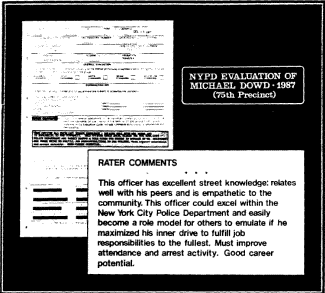
NYPD EVALUATION OF MICHAEL DOWD, 1987 (75TH PRECINCT)
RATER COMMENTS: This officer has excellent street knowledge: relates well with his peers and is empathetic to the community. This officer could excel within the New York City Police Department and easily become a role model for others to emulate if he maximized his inner drive to fulfill job responsibilities to the fullest. Must improve attendance and arrest activity. Good career potential.
The supervisor's explanation for this evaluation at a private hearing was that although Dowd was a disciplinary problem, he was changing his ways. Dowd, like many other openly corrupt officers with whom we spoke, reported that this lack of strong supervision and many supervisors' apparent willful blindness made him believe that he could "do just about anything and get away with it" (Tr. 150)
Resource and Management Failures
But field supervisors are not the sole culprits here. The Department's management is largely to blame for this state of supervision. Indeed, it is the Department's past Police Commissioners and top managers who, through their inaction and silence, permitted this situation to exist. It is the Department's top commanders who let supervisors off the hook and let command accountability wither. It is true that past Police Commissioners had other important priorities and concerns and they carried these out with skill and efficiency. But that does not excuse their failure to maintain strong supervision and command accountability.
The Commission found that supervisory conditions and resources were often so poor that even supervisors committed to fighting corruption could not do so successfully. For example, although sergeants are often in the best position to know about, confront, and deter corruption, conditions often prevented them from doing so.
We observed a critical shortage, and misallocation, of sergeants within the Department. This caused unmanageable ratios of supervisors to subordinate officers ("spans of control") in many precincts. Virtually all of the sergeants we interviewed testified that their spans of control were too large to effectively supervise their subordinates. Despite the fact that experts informed us that the proper ratio of sergeants to officers should be one sergeant for every ten officers, we found that in some precincts, sergeants were routinely responsible for supervising over thirty patrol officers spread throughout the precinct.
It was also not uncommon for supervisors to be responsible for simultaneous supervision of officers assigned to two separate precincts. Indeed, one former sergeant in the 75th Precinct testified that during her probationary period as a new sergeant, she was routinely the only sergeant on duty responsible for supervising the crime-ridden and corruption-prone 75th and 73rd Precincts where Dowd, Hembury and their corrupt colleagues were assigned. One lieutenant assigned to a busy precinct had recently been given the impossible task of being the sole supervisor for three precincts on a Saturday night. The only support the lieutenant was provided: two walkie-talkie radios. What this means is that in reality a vast number of officers, often in the most corruption-prone precincts, carry out their jobs without any supervision at all -- as these officers know all too well.
To make matters worse, we also found that sergeants typically perform a host of administrative duties that require them to devote more time to paperwork than to the field. In many high-crime precincts, sergeants do no supervising at all. Besides their long list of administrative duties, many sergeants were routinely responsible for handling calls for service ("radio runs"), not in a supervisory capacity, but merely to fill in for busy patrol officers who are supposed to handle these calls. One sergeant from a Queens precinct testified in a private hearing that it was not unusual for her to respond to a number of runs in a single tour: "The only difference between me and one of my people in that situation was that as a sergeant I got driven to the job by a driver." A patrol sergeant in a busy Bronx precinct indicated that it was not unusual for him to handle ten radio runs himself while simultaneously attempting to carry out his long list of supervisory duties. Even worse, the evidence indicates that this problem is often most severe on weekends and on late tours of duty -- when corruption opportunities are more frequent -- because fewer officers are available to handle the volume of radio calls. Under such conditions, it is practically impossible for sergeants to know what their subordinates are doing at any given time.
Moreover, sergeants have suffered a considerable dilution of authority over recent years. When forced to perform the duties of their subordinates, it is difficult for sergeants to establish the authority they need to be effective supervisors. As one patrol sergeant testified: "The result is that cops look at the sergeant running around handling the same jobs they are. He's not supervising; he's just another pawn and his authority suffers."
The Commission found additional reasons for this dilution of authority among supervisors, particularly sergeants. In today's Department, sergeants are younger and less experienced, and often have strong allegiances to the officers under their command rather than to the Department's management. Currently, an officer may take the sergeant's examination after only eighteen months of experience -- i.e., immediately after his term as a probationary officer expires. As a result, many sergeants have great difficulty establishing credibility and command authority. They find it difficult to effectively control and discipline officers with whom they are friendly, or seasoned veterans by whom they are intimidated. In short, in many commands throughout the Department today, sergeants are no longer perceived by officers -- or themselves -- as "bosses."
What is particularly troubling about these supervisory failures is that they are often most acute in those crime-ridden precincts where corruption opportunities most abound, and where effective, experienced supervisors are most needed. Many officers reported that Department commanders often assigned sergeants and other supervisors to high-crime precincts without regard to prior experience, training or the needs of the particular command. Too often, inexperienced, probationary sergeants were assigned to busy, corruption-prone precincts where experienced and proven supervisors were most needed. This practice is even more alarming because the Department also often sent those officers with disciplinary problems, those most susceptible to corruption and most in need of effective supervision, to these crime-ridden precincts -- which are widely perceived as the Department's "dumping grounds.
Integrity Control Officers
We also found that the Department failed to support the very supervisors responsible for helping to insure integrity in our City's precincts: the Integrity Control Officer ("ICO"). This is the one precinct supervisor responsible for assisting commanders with corruption detection and prevention. What began as a sensible program to minimize corruption has become an administrative failure. The ICO position is currently regarded as one of the least desirable and rewarding positions in a precinct. Most lieutenant ICOs we interviewed candidly told us that they spent little time controlling corruption and most of their time tending to paperwork and administrative matters. They typically described their job as a secretary to the precinct commander rather than as corruption fighters. Most ICOs had few resources, and received little training in what their duties are, much less in how to conduct corruption investigations. In fact, ICOs are rarely, if ever, consulted about internal investigations in their commands -- even though many have valuable information that could assist Internal Affairs investigators.
Some claim that ICOs have been kept ignorant of corruption investigations to prevent leaks of information. Furthermore, IAD never perceived the ICOs as part of the anticorruption apparatus. This practice should change. ICOs must be selected on their ability to be trusted with confidential information, and they must be given the resources, training and authority to carry out their important jobs throughout the Department.
***
The Commission recognizes that policing is an activity that inevitably makes "close supervision" more of a myth than a reality. We also recognize that even close supervision will not be a panacea to end corruption: determined corrupt officers will succeed even under the best supervisors. But effective supervision is a vital element of corruption control. That element has been sorely lacking in the past.
In recent months, the Department has moved to correct many of the supervision problems identified by the Commission in its Interim Report and public hearings. An important function of the independent outside monitor we recommend will be to insure that this important component of the anti-corruption apparatus does not again collapse -- particularly in those precincts where corruption opportunities most abound and effective supervision is most needed.
IV. THE DETERIORATION OF THE INVESTIGATIVE STRUCTURE: THE COLLAPSE OF IAD AND THE FIAUS
The Internal Affairs Division
We found that IAD had virtually abandoned its primary functions over the past years: to investigate serious, complex and sensitive corruption cases; to oversee, assist and insure the quality of the FIAUs; and to conduct analysis on corruption trends to assist the FIAUs and itself in investigating corruption. And most alarming, no one in the Department seemed to care.
From the beginning of our inquires, IAD investigators cooperating with the Commission told us that the work ethic in IAD was to close cases with as little effort as possible. Most IAD investigators, we were told, did nothing all day. One officer told us they sit around and "eat donuts and do crossword puzzles" -- and the supervisors and commanders did little more. Indeed, the Commission conducted an anonymous survey of the work conditions and attitudes of IAD investigators which revealed that almost half of IAD investigators' time was spent on non-investigatory matters -- and most of their "investigative" work was done without ever leaving their office. The perception that most officers outside of IAD had of it was similar. IAD suffered a deserved reputation for attracting poor investigators, of focusing on petty misconduct rather than serious corruption, and on conducting "armchair investigations" -- in the comfort of their offices rather than in the field.
The facts confirmed IAD's do-nothing reputation. To begin with, it handled a negligible number -- 5 percent -- of corruption cases each year. Although IAD had approximately one hundred and fifty officers, ninety of whom handled cases, it kept a mere one hundred thirty-three corruption cases a year for itself -- and assigned all the rest to the over-burdened FIAUs. Thus, IAD investigators handled an average of two new cases a year. It is important to note that IAD's top commanders from 1986 through 1992 -- Chief Daniel Sullivan, Assistant Chiefs John Moran and Robert Beatty, Deputy Chief William Carney and Inspector Michael Pietrunti and Deputy Inspector Thomas Callahan -- were responsible for selecting or approving the quantity and quality of cases IAD and the FIAUs would handle each year.
In contrast, IAD assigned the FIAUs -- which had woefully insufficient resources and personnel -- 95 percent of all the Department's corruption cases: over twenty-five hundred a year. FIAU investigators consequently handled what even their commanders conceded was an impossible caseload: an average of 18 cases per investigator, with investigators in high-crime precincts where corruption is most frequent handling up to thirty to forty cases at any given time. The following exhibit makes this clear:
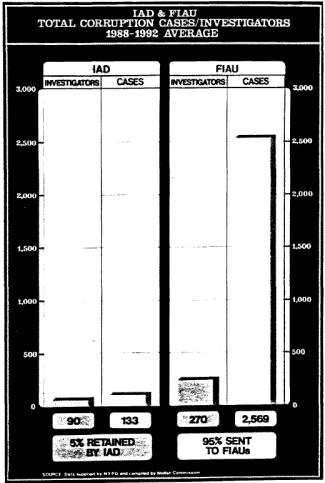
IAD & FIAU: TOTAL CORRUPTION CASES/INVESTIGATORS, 1988-1992 AVERAGE
5% RETAINED BY IAD
95% SENT TO FIAUs
This massive discrepancy in caseloads could possibly be justified if IAD bad been fulfilling its mandate to retain and investigate only the most serious and complex corruption cases. The facts showed the opposite was true.
Many of the cases that IAD's top commanders decided to retain for IAD were the simple, easy-to-solve "ground ball" cases that did not require much investigative effort. In fact, we found that approximately one-third of all cases that IAD's commanders retained were allegations of petty misconduct including: officers being off-post, sleeping on duty, or misusing police parking permits. The following exhibit makes this clear:
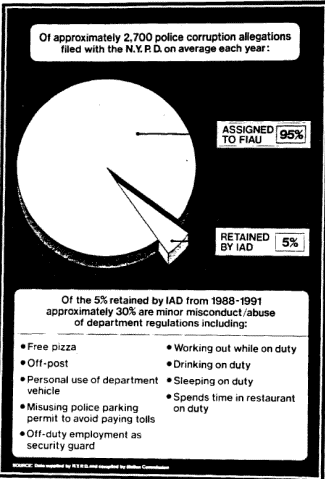
Of approximately 2,700 police corruption allegations filed with the N.Y.P.D. on average each year:
ASSIGNED TO FIAU: 95%
RETAINED BY IAD: 5%
Of the 5% retained by IAD from 1988-1991 approximately 30% are minor misconduct/abuse of department regulations including:
• Free pizza
• Off-post
• Personal use of department vehicle
• Misusing police parking permit to avoid paying tolls
• Off-duty employment as security guard
• Working out while on duty
• Drinking on duty
• Sleeping on duty
• Spends time in restaurant on duty
When questioned on this matter, however, Chief Sullivan testified that not only would IAD not keep such minor cases, but many of them should never even have been classified as corruption cases. Moreover, although IAD's chiefs received daily summaries of all IAD cases, many indicated they were unaware that IAD had so obviously abandoned its mission to investigate serious corruption.
After the creation of this Commission, IAD swiftly began to remember its mission. It began to investigate more serious cases, and retained 40 percent fewer petty misconduct cases in the year following the Commission's establishment than in the previous four years. The former Commanding Officer of IAD's Records Section, Sergeant Steven Webber, testified that he attributed this decline to the existence of scrutiny independent of the Department's chain of command.
Despite the petty nature and small quantity of IAD's cases, it nevertheless closed as unsubstantiated more than 60 percent of its cases, indicating its investigators found insufficient evidence to either prove or disprove the allegation. Most alarmingly, our investigation revealed that many of these cases were closed as unsubstantiated before all basic investigatory steps were taken.
We also found that the number of cases IAD claimed in Department records to have substantiated every year was inflated and inaccurate. To investigate this issue, a team of Commission investigators reviewed every case IAD closed as "substantiated" over the past five years. We found that in many of these cases IAD had closed the main corruption allegation as unsubstantiated, or recorded as its own an allegation substantiated by another law enforcement agency. In other words, IAD bolstered its statistics by including successful corruption investigations undertaken outside IAD.
Equally disturbing, we found that IAD's claimed substantiation rates were inconsistent, and were calculated in a manner that Lieutenant Donald Poliseno, the Commanding Officer of the IAD Analysis Unit, testified "doesn't make any common sense." In sum, although IAD's reporting lines and practices looked good on paper, in practice, they were largely a sham.
IAD's top commanders had unbridled control over the Department's investigations with no accountability. No other Division in the Department had such unreviewed discretion. Obviously when no one reviews performance or demands results, performance wanes -- as the Department's top commanders no doubt knew, or should have known.
The Field Internal Affairs Units
The Department also allowed IAD's oversight of the FIAUs to erode -- and the entire FIAU structure virtually to collapse. Although an entire IAD unit (the Staff Supervisory Unit) was, in theory, charged with overseeing and assisting the FIAUs, our inquiries revealed that IAD hardly attempted to carry out this critical task. To the contrary, the evidence shows that IAD withheld vital assistance, information and resources from the FIAUs. Numerous IAD and FIAU officers reported that IAD would not even share essential information or witnesses with the FIAUs; and that the "unwritten policy" was to deny the FIAUs access to IAD investigative files -- even those with information on officers that the FIAUs were investigating.
For example, when investigators from Manhattan South's FIAU were questioned in private interviews about a large corruption investigation they had conducted in the 9th Precinct, they learned for the first time, through the Commission's inquiries, about an IAD investigation into the very same precinct at around the same time as their investigation. In the Michael Dowd investigation, Sergeant Joseph Trimboli, the FIAU investigator who pursued Dowd for five years, testified that he first became aware of vital information that IAD had about Dowd in the course of the Commission's questioning at a private hearing.
When interrogated about this senseless practice, IAD commanders denied knowledge of this "no access" policy -- which was widely known and acknowledged by lower-ranking IAD officers and by FIAU officers of all ranks. One IAD detective, to whom we promised confidentiality, who had served in the IAD unit that purportedly oversaw and assisted the FIAUs, testified in a private hearing: "There was no sharing of information between [IAD] and the FIAUs. IAD did not trust the FIAUs at all ... [there was] fear of disclosure of confidential information that could be an embarrassment to the Department ... The evidence suggests that the secrecy IAD built around its cases was designed not to protect confidentiality, but to limit the scope and the success of the FIAUs' investigations. It also created a deep hostility and distrust that divided the Department's entire investigative apparatus.
Department commanders also crippled the FIAUs by denying them adequate resources and personnel. FIAU officers of all ranks -- from the former Commanding Officer of Brooklyn North's PIAU to officers in Manhattan South's FIAU -- testified that they simply did not have the basic equipment needed to investigate police corruption in their boroughs. One PIAU investigator told the Commission that the lack of available resources got so unbearable that she went to a local magic shop to purchase a disguise so she could conduct surveillances on foot because the FIAU cars and investigators were so well known among cops in the high-crime precincts she was investigating.
Insufficient resources, however, was only part of the problem. The volume of serious cases that IAD's top commanders -- including Callahan, Carney, Moran, and Beatty -- routinely assigned or approved for the FIAUs, coupled with the FIAUs' understandably dismal performance in investigating so many cases, further suggests that the Department knowingly sent many police corruption cases to the FIAUs to die.
For the top commanders in IAD and the Department to knowingly allow the FIAUs to become the graveyard for the overwhelming majority of police corruption cases again reflects the Department's preference to bury rather than confront the problem of police corruption.
V. FRAGMENTING, MINIMIZING AND CONCEALING POLICE CORRUPTION CASES
The New York City Police Department is nationally renown for its skill and accomplishments in criminal investigations. It aggressively pursues complex criminal investigations, employs creative and advanced investigation methods, and gathers information from every available source. This is true, we found, in all areas of investigation other than police corruption.
Minimizing Corruption Through Investigations
IAD officers and others who assisted the Commission told us early in our tenure that the Department's approach to investigating police corruption was to minimize potentially embarrassing cases by closing them before all basic investigatory steps had been taken, by fragmenting broad patterns of corruption information into isolated allegations, and by minimizing the scope of corruption they would pursue.
The evidence bore this out. We found that police corruption cases were often closed prematurely, minimized, and fragmented into separate parts, which insured that the nature and extent of corruption uncovered would be minimal. The difficult issue was to determine whether this reflected a knowing cover up, simple incompetence, or both. The Department maintained -- until our public hearings -- that the failures of the system reflected a mere lack of coordination and resources rather than willful neglect or a reluctance to uncover serious corruption. Our findings suggest that was not always the case.
Two matters presented at the Commission's public hearings illustrate how investigations intentionally were prematurely closed or fragmented to avoid a large corruption scandal.

